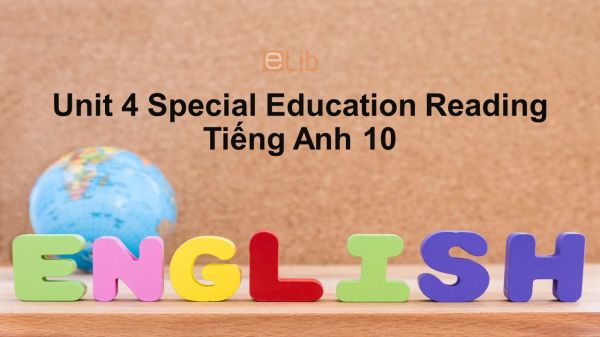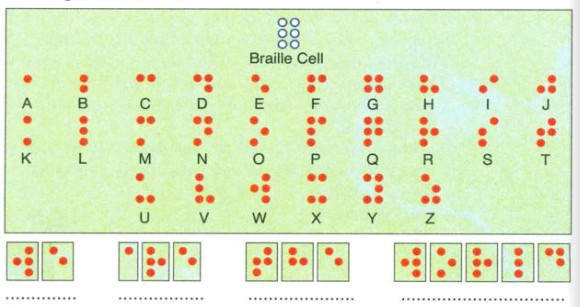Unit 4 lớp 10: Special Education-Reading
Bài học Unit 4 lớp 10 "Special Education" phần Reading hướng dẫn các em đọc hiểu nội dung bài về chương trình giáo dục đặc biệt cho học sinh khuyết tật.
Mục lục nội dung

Unit 4 lớp 10: Special Education-Reading
1. Before You Read Unit 4 lớp 10
Make a list or the activities you do every day. Then ask your partner which ones he / she thinks would be difficult for blind and deaf people (Lập danh sách những hoạt động em làm mỗi ngày. Sau đó hỏi một bạn cùng học những họat động nào bạn ấy nghĩ sẽ khó khăn cho những người mù và điếc)
Guide to answer
- In the morning
- brush my teeth
- do exercise
- take a bath
- have breakfast
- In the afternoon
- take a nap
- do my homework and exercise
- play sports with friends
- go to school
- In the evening
- watch TV, about half an hour
- learn lessons/do exercises
- go to bed, at about 10:30.
Hội thoại:
A. Which activities do you think may be difficult for blind and deaf people?
B. I think playing sports, watching TV and going to school by themselves are difficult for these people. And we can say these activities are impossible for them.
Tạm dịch:
Vào buổi sáng
đánh răng
tập thể dục
tắm
ăn sáng
Vào buổi chiều
ngủ một giấc
làm bài tập về nhà
chơi thể thao với bạn bè
đến trường
Vào buổi tối
xem TV, khoảng nửa tiếng
học bài/làm bài tập
đi ngủ, khoảng 10:30
Cuộc hội thoại:
A. Bạn nghĩ hoạt động nào có thể gây khó khăn cho người mù và người điếc?
B. Tôi nghĩ chơi thể thao, xem TV và đi học là rất khó cho những người này. Và chúng ta có thể nói những hoạt động này là không thể đối với họ.
Work with a partner. Look at the Braille Alphabet. Then work out the message that follows (Làm việc với một bạn cùng học. Nhìn vào bảng mẫu tự Braille. Sau đó trả lời nhắn theo sau)

Unit 4: Special Education - Reading
Guide to answer
a. we b. are c. the d. world
Tạm dịch:
a. chúng tôi b. là c. (mạo từ) d. thế giới
2. While You Read Unit 4 lớp 10
Read the passage and then do the tasks that follow (Đọc đoạn văn sau đó làm bài tập theo sau)
A TEACHER IN A SPECIAL CLASS
Like other teachers, Pham Thu Thuy enjoys her teaching job. However, her class is different from other classes. The twenty-five children, who are learning how to read and write in her class, are disabled. Some are deaf, some dumb and others mentally retarded. Most of the children come from large and poor families, which prevents them from having proper schooling.
At first, there was a lot of opposition from the parents of the disabled children. They used to believe that their children could not learn anything at all. In the first week, only five children attended the class. Gradually more children arrived. Their parents realised that the young teacher was making great efforts to help their poor kids.
Watching Thuy taking a class, one can see how time-consuming the work is. During a maths lesson, she raised both arms and opened up her fingers one by one until all ten stood up. She then closed the fingers one by one. She continued the demonstration until the children realised they had just learned how to add and subtract. The children have every reason to be proud of their efforts. They know a new world is opening up for them.
Tạm dịch bài:
GIÁO VIÊN Ở MỘT LỚP HỌC ĐẶC BIỆT
Như các giáo viên khác, Phạm Thu Thủy yêu nghề dạy học. Tuy nhiên lớp của cô khác hẳn các lớp khác. Hai mươi lăm học sinh đang học đọc và viết trong lớp là trẻ khuyết tật. Một số em bị câm, một số em bị điếc và các em khác chậm phát triển trí tuệ. Hầu hết, gia đình các em là những gia đình nghèo khó khiến các em không thể học hành tới nơi tới chốn.
Thoạt đầu ba mẹ các em rất phản đối việc cho con đi học. Họ vẫn tin là con họ chẳng thể học được điều gì. Trong tuần lễ đầu tiên chỉ có năm em đến lớp. Dần dần bọn trẻ đi học đông hơn. Cha mẹ chúng nhận ra rằng cô giáo trẻ đã rất nỗ lực để giúp trẻ em nghèo.
Nhìn cô Thủy đứng lớp, người ta có thể thấy được công việc của cô tốn nhiều thời gian thế nào. Trong giờ học Toán, cô đưa cả hai cánh tay ra, giơ lên từng ngón một cho đến khi đủ cả mười ngón. Sau đó cô cụp từng ngón tay lại. Cô tiếp tục làm như thế cho đến khi bọn trẻ nhận ra rằng chúng đã học được cách cộng trừ. Bọn trẻ có lý do để tự hào về nỗ lực cùa mình. Các em biết rằng một thế giới đang mở ra cho các em.
2.1. Task 1 Unit 4 lớp 10
The words in A appear in ihe reading passage. Match them with their definitions in B (Các từ ở cột A xuất hiện ở bài đọc. Ghép chúng với những định nghĩa ở cột B)
A
1. disabled
2. mentally retarded
3. time-consuming
4. demonstration
5. gradually
B
a. taking or needing a lot of time
b.an act of showing or explaining how to do something
c. unable to use a part of the body in the normal way
d. slowly, over a long period of time
e. less mentally developed than normal
Guide to answer
1 - c ; 2 - e ;
3 - a ; 4 - b : 5 - d
Tạm dịch:
1. disabled: không thể sử dụng một phần cơ thể theo cách thông thường
2. mentally retarded: ít phát triển về tinh thần hơn bình thường
3. time-consuming: dùng hoặc cần rất nhiều thời gian
4. demonstration: một hành động thể hiện hoặc giải thích cách làm điều gì đó
5. gradually: từ từ, trong một thời gian dài
2.2. Task 2 Unit 4 lớp 10
Read the passage again and complete the following sentences by circling the corresponding letter A, B,C or D (Đọc lại đoạn văn và điền những câu sau bằng cách khoanh tròn mẫu tự tương ứng A, B, C hoặc D)
1. Thuy’s class is different from other classes because the children____ .
A. are from large families
B. are less mentally developed
C. love Maths very much
D. are disabled
Tạm dịch:
Lớp học của Thúy khác với các lớp khác vì trẻ em _____.
A. là từ các gia đình đông con
B. ít phát triển về tinh thần hơn
C. rất yêu Toán
D. bị khuyết tật
2. At first the parents were _____ the idea of sending their children to the special class.
A. interested in C. satisfied with
B. opposed to D. worried about
be satisfied with sth: hài lòng với cái gì
Tạm dịch:
Lúc đầu, cha mẹ _____ ý tưởng gửi con cái của họ đến lớp đặc biệt.
A. quan tâm đến C. hài lòng với
B. phản đối D. lo lắng về
3. It can be inferred from the second paragraph of the reading passage that there has been _____ .
A. a change in the parents' attitude towards the class
B. a lot of protest from the parents against the class
C. a feeling of doubt in the teacher’s ability
D. a belief in the parents' opposition
Tạm dịch:
Nó có thể được suy ra từ đoạn thứ hai rằng đã có _____.
A. thay đổi thái độ của cha mẹ đối với lớp học
B. rất nhiều phản đối từ cha mẹ chống lại lớp học
C. một cảm giác nghi ngờ về khả năng của giáo viên
D. một niềm tin vào sự phản đối của cha mẹ
4. The writer describes how Thuy teaches the children to add and subtract in order to prove that_____ .
A. the children like Maths
B. the teacher is proud of her work
C. the teaching work takes time
D. adding and subtracting are important
Tạm dịch:
Tác giả mô tả cách thức Thúy dạy cho trẻ em cách cộng và trừ để chứng minh rằng ___.
A. những đứa trẻ thích Toán
B. giáo viên tự hào về công việc của mình
C. công việc giảng dạy cần có thời gian
D. cộng và trừ là quan trọng
5. The writer's attitude towards Thuy’s work in the passage can be described as ______.
A. humorous B. angry
C. suspicious D. admiring
Tạm dịch:
Thái độ của nhà văn đối với công việc của Thúy trong đoạn văn có thể được mô tả là ______.
A. hài hước B. giận dữ
C. đáng ngờ D. ngưỡng mộ
3. After You Read Unit 4 lớp 10
Fill each of the blanks of the summary below with a suitable word from the reading passage (Điền vào chỗ trống của bài tóm tắt dưới đây với từ thích hợp từ bài đọc)
Twenty-five (1)______ children have the chance of learning how to (2)_______ and (3)_______ to the (4)______ of a young teacher, Pham Thu Thuy.
Although her idea, at first, met with (5)_______ from the parents of the disabled children, more children attended her class later. The teaching work in the special class is (6)_______.
For example, in a (7)______ lesson, the teacher has to use her (8)______ and (9)_______to teach the children how to add and subtract. The children are now (10)_______ and happy.
Hướng dẫn giải:
Twenly-five (1) disabled children have the chance of learning how to (2) read and (3) writethanks to the (4) efforts of a young teacher, Pham Thu Thuy.
Although her idea, at first, met with (5) opposition from the parents of the disabled children, more children attended her class later. The touching work in the special class is (6) time-consuming.
For example, in a (7) Maths lesson, the teacher has to use her (8) arms and (9) fingers to teach the children how to add and subtract. The children are now (10) proud and happy.
Tạm dịch:
Hai mươi lăm trẻ em khuyết tật có cơ hội học cách đọc và viết vì những nỗ lực của một giáo viên trẻ, Phạm Thu Thuý.
Mặc dù ý tưởng của cô, lúc đầu, gặp phải sự phản đối từ cha mẹ của những đứa trẻ khuyết tật, nhiều trẻ em đã tham dự lớp học của cô sau này. Công việc trong lớp đặc biệt tốn thời gian.
Ví dụ, trong bài học Toán, giáo viên phải sử dụng cánh tay và ngón tay để dạy cho trẻ em cách cộng và trừ. Các em bây giờ rất tự hào và hạnh phúc.
4. Practice
4.1. Choose the correct answer
1. Why is Ms Thuy’s class different from other classes?
A. The children are disabled B. All the children are girls
C. All the children are boys. D. The children are excellent.
2. Disabled children means:
A. They are dumb B. They are deaf
C. They are mentally retarded D. All are correct
3. Most of the children in Ms Thuy’s class are …………………..
A. rich B. poor
C. intelligent D. brilliant
4. Why did their parents refuse to send their children to school at first?
A. Because they were too poor to send their children to school.
B. Because they thought that their children couldn’t learn anything.
C. Because the children had to earn money.
D. Because they thought learning is not good.
5. Teaching this kind of class is ………………………..
A. easy B. boring
C. time-consuming D. interesting
4.2. Multiple-choice
Để rèn luyện kĩ năng đọc hiểu với chủ đề "Special Education", mời các em đến với phần trắc nghiệm Unit 4 Reading Tiếng Anh 10 và cùng luyện tập.
5. Conclusion
Qua bài học này, các em cần ghi nhớ một số từ vựng quan trọng trong bài học như sau
- list (n) [list]: danh sách
- blind (n) [blaind]: mù
- deaf (n) [def]: điếc
- mute (n) [mju:t]: câm
- alphabet (n) ['ælfəbit]: bảng chữ cái
- work out (v) [wə:k, aut]: tìm ra
- message (n) ['mesidʒ]: thông điệp
- doubt (n) [daut]: sự nghi ngờ
- speacial (adj) ['spe∫l]: đặc biệt
- disabled (adj) [dis'eibld]: tàn tật
- dumb (adj) [dʌm]: câm
- mentally (adv) ['mentəli]: về mặt tinh thần
- retarded (adj) [ri'tɑ:did]: chậm phát triển
- prevent sb from doing sth (exp.): ngăn cản ai làm gì
- proper (adj) ['prɔpə]: thích đáng
- schooling (n) ['sku:liη]: sự giáo dục ở nhà trường
- opposition (n) [,ɔpə'zi∫n]: sự phản đối
- gradually (adv) ['grædʒuəli]: từ từ
- arrive (v) [ə'raiv]: đến
Tham khảo thêm
- doc Unit 4 lớp 10: Special Education-Speaking
- doc Unit 4 lớp 10: Special Education-Listening
- doc Unit 4 lớp 10: Special Education-Writing
- doc Unit 4 lớp 10: Special Education-Language Focus




